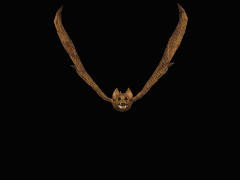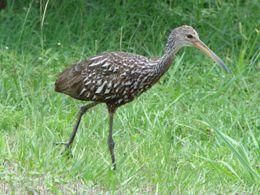


|
Gruiformes:
The diverse order Gruiformes contains some 10 living and about a dozen extinct bird families with, on first sight, little in common. Gruiform means "crane-like”.
Traditionally, a number of wading and terrestrial bird families that did not seem to belong to any other order were classified together as Gruiformes. These included the large land-based bustards which include the heaviest living birds able to fly, the very large cranes, or the relatively small and secretive water-loving crakes and rails (all families with a wide distribution and a dozen or more member species), as well as a variety of very small families, some of them containing just a single species such as the enigmatic Kagu of the stunning Sunbittern. On first sight, the Gruiformes seem to have little in common with one another because they are morphologically diverse. However, anatomical evidence indicates that several groups within the traditional Gruiformes do appear to be evolutionarily related. Several infraorders of Gruiformes are recognized. The Rallidae and the Heliornithidae are associated as the Ralli (although the Rallidae are sometimes separated as order Ralliformes). Aramidae, Gruidae and the Psophiidae form the Grui.
A number of potential candidates for Gruiformes status have been rejected by Sibley & Ahlquist (1990) based on DNA-DNA hybridization studies. Their research led them to remove the Otidae, Eurypygidae, Rhynochetidae, Cariamidae, Mesitornithidae and Turnicidae from the Gruiformes. The Eurypygidae and Rhynochetidae were similar to Ardeiformes, and are therefore associated with certain birds that are traditionally interpreted as Ciconiiformes and others such as Charadriiformes in a vastly expanded Ciconiiformes. The Mesitornithidae and Cariamidae were indicated to be close to the Cuculiformes, but the Otididae did not seem to be close to other extant birds and on the placement of the Turnicidae they could reach no firm conclusion. However, it must be noted that DNA-DNA hybridization is often insufficient to determine more than the most basic phylogenies; Sibley & Ahlquist's "Ciconiiformes" are not a natural group for example. DNA sequence analyses has led to the Plains Wanderer - which was formerly believed to be an aberrant buttonquail in the Gruiformes - being reassigned as a charadriiform wader related to jacanas. The buttonquails, however, have in the meantime also turned out to be Charadriiformes, but form a lineage distinct from all other members of that order (van Tuinen et al., 2005; Paton & Baker, 2006). A notable feature in several gruiform lineages is that flighlessness evolves far more easier than in most other birds. About one-third of the extinct families were at least partially flightless, and numerous living and extinct rails are known. |
